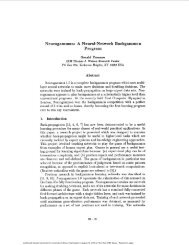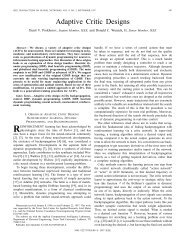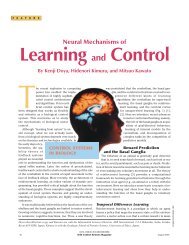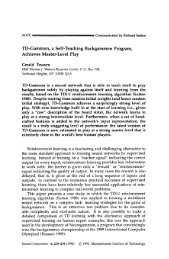Neural-Network-Based State Feedback Control of a ... - IEEE Xplore
Neural-Network-Based State Feedback Control of a ... - IEEE Xplore
Neural-Network-Based State Feedback Control of a ... - IEEE Xplore
Create successful ePaper yourself
Turn your PDF publications into a flip-book with our unique Google optimized e-Paper software.
JAGANNATHAN AND HE: NN-BASED STATE FEEDBACK CONTROL OF A NONLINEAR DISCRETE-TIME SYSTEM 2079<br />
Fig. 2.<br />
Adaptive-critic-NN-based controller structure.<br />
where is defined in (44), , and the subscript<br />
“ ” stands for the “first action NN.” The value for the desired<br />
strategic utility function is taken as “0” [18], i.e., to indicate<br />
that at every step, the nonlinear system can track the reference<br />
signal well. Thus, (59) becomes<br />
(60)<br />
The objective function to be minimized by the first action NN<br />
is given by<br />
(61)<br />
The weight update rule for the action NN is also a gradientbased<br />
adaptation, which is defined as<br />
(62)<br />
where<br />
(63)<br />
or<br />
(64)<br />
where is the NN adaptation gain.<br />
The NN weight updating rule in (64) cannot be implemented<br />
in practice because the target weight is unknown. However,<br />
using (43), the functional estimation error is given by<br />
Substituting (65) into (64), we get<br />
(65)<br />
F. Weight Updating Rule for the Second Action NN<br />
Define<br />
(68)<br />
where is defined in (50), , and ,<br />
where the subscript “ ” stands for the “second action NN.”<br />
Following the similar design procedure and taking the bounded<br />
unknown disturbance and the NN approximation error<br />
to be zeros, the second action NN<br />
weight updating rule is given by<br />
(69)<br />
The proposed adaptive critic architecture based on weight<br />
tuning (67) and (69) with and is similar to supervised<br />
actor–critic architecture [10] wherein the supervisory<br />
signals and supply an additional source <strong>of</strong> evaluative<br />
feedback or reward that essentially simplifies the task<br />
faced by the learning system. As the actor gains pr<strong>of</strong>iciency,<br />
the supervisory signals are then gradually withdrawn to shape<br />
the learned policy towards optimality.<br />
To implement (69), the value <strong>of</strong> at the instant<br />
has to be known, which can be obtained by the following steps.<br />
1) Calculate , , , , , ,<br />
, and at the instant.<br />
2) Apply the control input to system (3) to obtain the<br />
states and .<br />
3) Use the tracking error definition to get as<br />
(70)<br />
(66)<br />
Assume that bounded disturbance and the NN approximation<br />
error are zeros for weight tuning implementation,<br />
then (66) is rewritten as<br />
(67)<br />
Equation (67) is the adaptive-critic-based weight updating rule<br />
for the first action NN<br />
. Next, we present the<br />
weight updating rule for the second action NN .<br />
4) Use the first action NN weight updating rule (66) to get<br />
.<br />
5) Once we have and , the value <strong>of</strong><br />
can be determined by using<br />
and<br />
(71)<br />
(72)<br />
The proposed adaptive critic NN controller is depicted in<br />
Fig. 2 based on the development given in this section. The desired<br />
and actual state <strong>of</strong> the first variable is utilized to obtain









